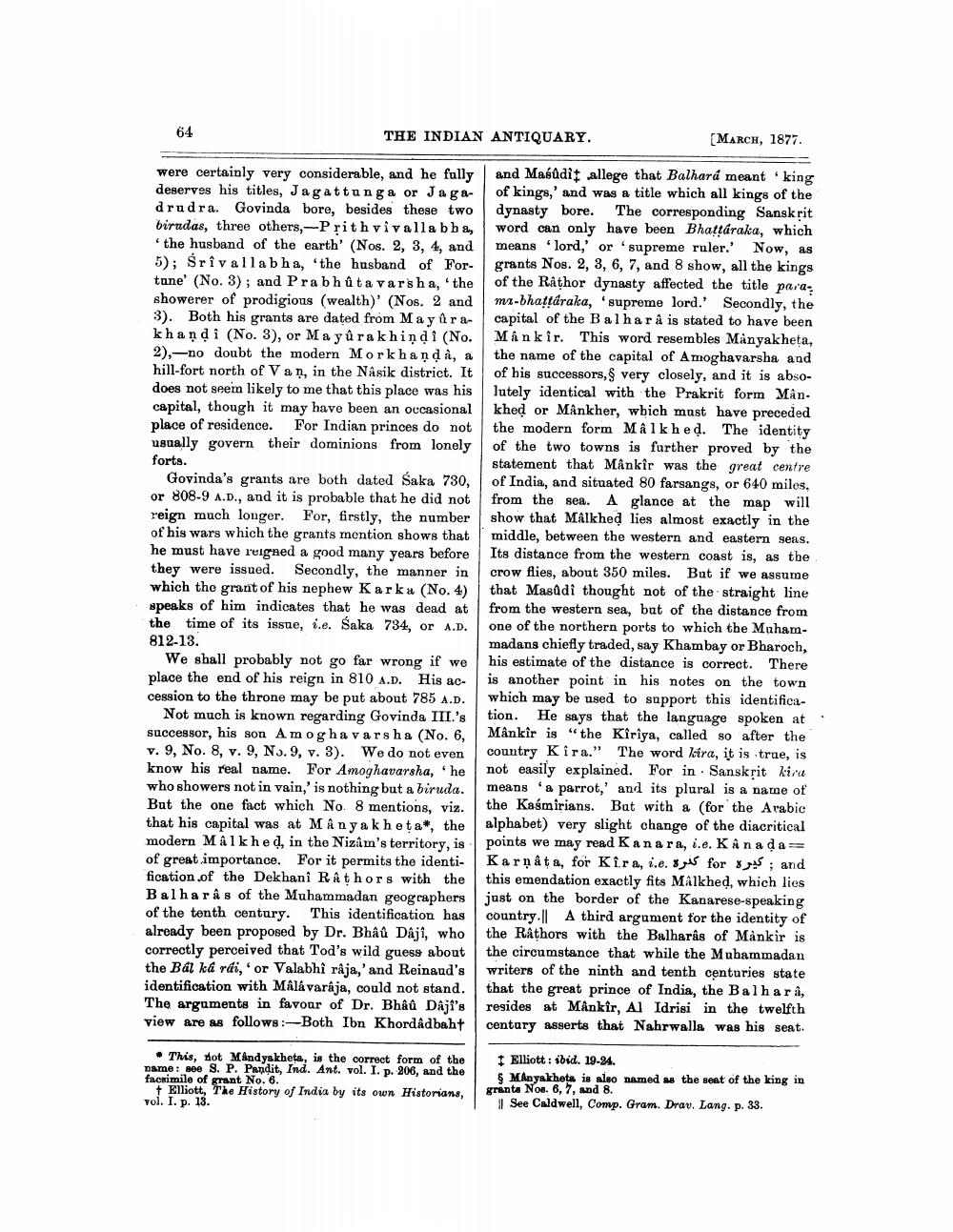________________
64
THE INDIAN ANTIQUARY.
were certainly very considerable, and he fully deserves his titles, Jagattunga or Jagadrudra. Govinda bore, besides these two biradas, three others,-Prithvivallabha, the husband of the earth' (Nos. 2, 3, 4, and 5); Śrivallabha, 'the husband of Fortune' (No. 3); and Prabhûta varsha, 'the showerer of prodigious (wealth)' (Nos. 2 and 3). Both his grants are dated from May û rakhandi (No. 3), or Mayûrakhindi (No. 2), no doubt the modern Morkhanḍà, a hill-fort north of V an, in the Nâsik district. It does not seem likely to me that this place was his capital, though it may have been an occasional place of residence. For Indian princes do not usually govern their dominions from lonely
forts.
Govinda's grants are both dated Saka 730, or 808-9 A.D., and it is probable that he did not reign much longer. For, firstly, the number of his wars which the grants mention shows that he must have reigned a good many years before they were issued. Secondly, the manner in which the grant of his nephew Karka (No. 4) speaks of him indicates that he was dead at the time of its issue, i.e. Saka 734, or A.D. 812-13.
We shall probably not go far wrong if we place the end of his reign in 810 A.D. His accession to the throne may be put about 785 A.D.
Not much is known regarding Govinda III.'s successor, his son Amoghavarsha (No. 6, v. 9, No. 8, v. 9, No. 9, v. 3). We do not even know his real name. For Amoghavarsha, 'he who showers not in vain,' is nothing but a biruda. But the one fact which No. 8 mentions, viz. that his capital was at Mânyakheta*, the modern Malkhed, in the Nizâm's territory, is of great importance. For it permits the identification of the Dekhani Rathors with the Balharâs of the Muhammadan geographers of the tenth century. This identification has already been proposed by Dr. Bhâû Dâjî, who correctly perceived that Tod's wild guess about the Bál ka rái, or Valabhi raja,' and Reinaud's identification with Mâlávarâja, could not stand. The arguments in favour of Dr. Bhâû Dâji's view are as follows:-Both Ibn Khordâdbaht
This, not Mandyakheta, is the correct form of the name: see S. P. Pandit, Ind. Ant. vol. I. p. 206, and the facsimile of grant No. 6.
Elliott, The History of India by its own Historians, vol. I. p. 13.
[MARCH, 1877.
and Masûdit allege that Balhará meant king of kings,' and was a title which all kings of the dynasty bore. The corresponding Sanskrit word can only have been Bhattáraka, which means lord,' or 'supreme ruler.' Now, as grants Nos. 2, 3, 6, 7, and 8 show, all the kings of the Râthor dynasty affected the title para mr-bhattáraka, 'supreme lord.' Secondly, the capital of the Balharâ is stated to have been Mankir. This word resembles Manyakheta, the name of the capital of Amoghavarsha and of his successors, § very closely, and it is absolutely identical with the Prakrit form Mânkhed or Mânkher, which must have preceded the modern form Malkhed. The identity of the two towns is further proved by the statement that Mânkîr was the great centre of India, and situated 80 farsangs, or 640 miles, from the sea. A glance at the map will show that Mâlkhed lies almost exactly in the middle, between the western and eastern seas. Its distance from the western coast is, as the crow flies, about 350 miles. But if we assume that Masûdi thought not of the straight line from the western sea, but of the distance from one of the northern ports to which the Muhammadans chiefly traded, say Khambay or Bharoch, his estimate of the distance is correct. There is another point in his notes on the town which may be used to support this identification. He says that the language spoken at Mânkir is "the Kiriya, called so after the country Kira." The word kira, it is true, is not easily explained. For in Sanskrit kira means a parrot,' and its plural is a name of the Kasmirians. But with a (for the Arabic alphabet) very slight change of the diacritical points we may read Kanara, i.e. Kanada == Karnata, for Kira, i.e. s for 85; and this emendation exactly fits Malkhed, which lies just on the border of the Kanarese-speaking country. A third argument for the identity of the Râthors with the Balharâs of Mankir is the circumstance that while the Muhammadan writers of the ninth and tenth centuries state that the great prince of India, the Balharâ, resides at Mânkir, Al Idrisi in the twelfth century asserts that Nahrwalla was his seat.
Elliott: ibid. 19-24.
§ Manyakheta is also named as the seat of the king in grants Nos. 6, 7, and 8.
See Caldwell, Comp. Gram. Drav. Lang. p. 33.




